When creating essential oil blends, follow these 7 key rules: understand oil families (like citrus and floral), use the 30-50-20 ratio (top, middle, base notes), test combinations on perfume strips, choose compatible scents that complement each other, balance therapeutic properties, create harmonious layers starting with base notes, and store properly in dark glass bottles. Let your blends mature for 48 hours in a cool, dry place. These fundamentals will set you up for countless successful aromatherapy combinations.
Understanding Essential Oil Families and Notes
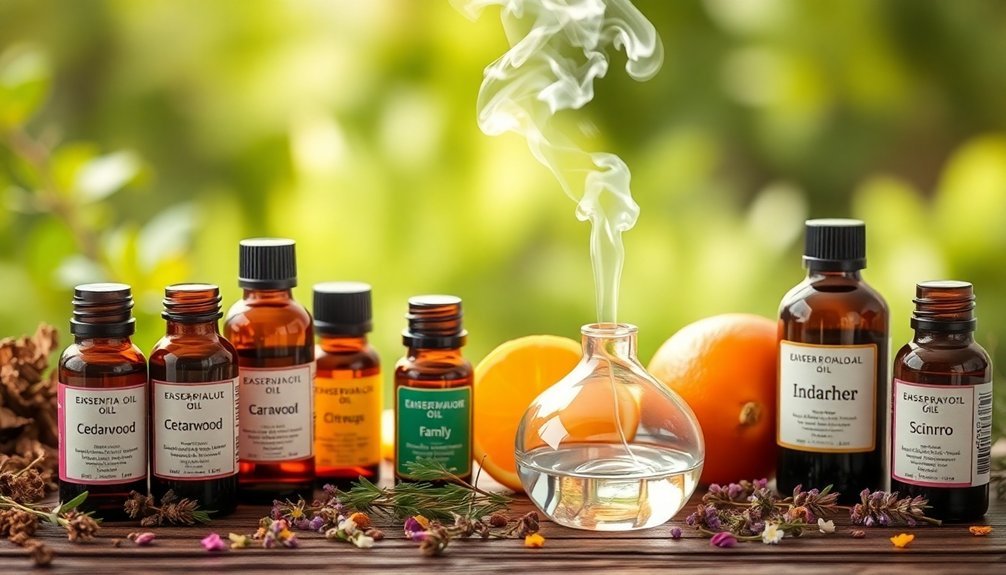
When exploring aromatherapy combinations, understanding essential oil families and notes forms the foundation for creating effective blends. Essential oils fall into distinct aromatic families like anisic, with its sweet licorice notes, citrus oils that provide uplifting aromas, florals that offer fragrant flower-like scents, and cineolic oils featuring fresh, camphor-like characteristics.
You'll also find oils grouped by their plant families. The Lamiaceae family includes calming herbs like lavender and peppermint, while Rutaceae comprises mood-boosting citrus oils.
The Myrtaceae family offers powerful antimicrobial oils like tea tree and eucalyptus, and the Asteraceae family provides gentle, soothing oils such as chamomile. Understanding these families helps you create harmonious blends, as oils within the same category typically work well together. Since scent perception varies between individuals, it's important to note that essential oil classification can be highly subjective and may differ based on personal experience.
The 30-50-20 Rule for Perfect Proportions
The art of blending essential oils becomes effortless with the 30-50-20 rule – a foolproof formula for creating balanced aromatherapy combinations. This simple ratio calls for 30% top notes, 50% middle notes, and 20% base notes in your blends.
For a practical 10-drop blend, you'll use 3 drops of top notes like lemon or bergamot, 5 drops of middle notes such as lavender or rosemary, and 2 drops of base notes like frankincense or sandalwood. The lighter molecules evaporate first, making top notes the initial scent you'll experience. You can easily scale this ratio up or down while maintaining these proportions.
Before finalizing your blend, let it rest for 24-48 hours to allow the fragrances to meld together.
You'll want to start with small test batches and adjust the ratios based on your sensory evaluation and personal preferences.
Testing Your Blends With Perfume Strips
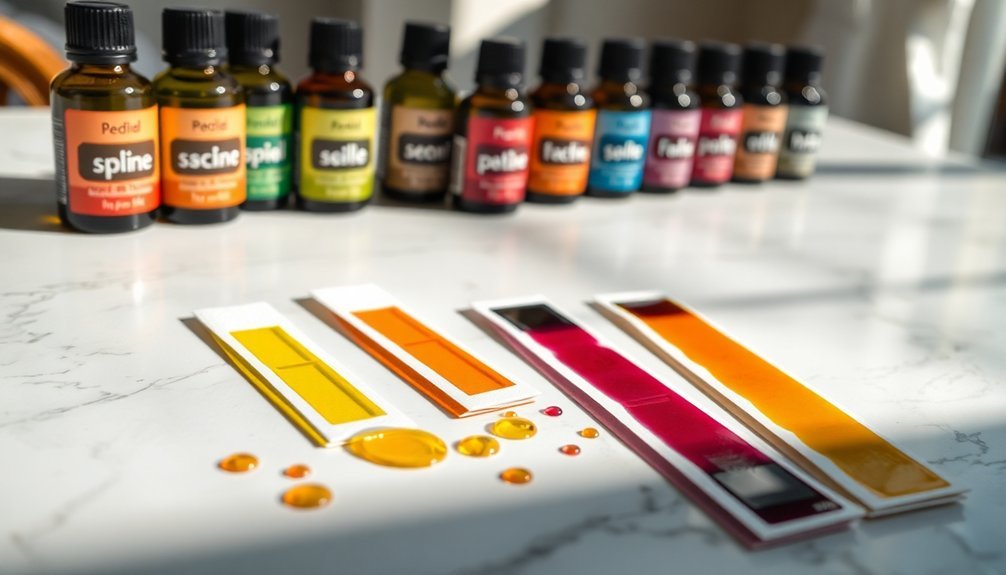
You'll get the most accurate sense of your essential oil blends by using the fan strip testing method, where you apply individual oils to separate strips and fan them together under your nose.
Professional perfumers rely exclusively on these test strips for the most accurate evaluations of aromatic oils.
To understand how your blend evolves, observe the scent changes at different time intervals – from the initial application to several hours later.
Test intensity variations by moving the strips closer or farther from your nose, which helps you fine-tune the proportions of each oil in your final blend.
Fan Strip Testing Methods
Testing essential oil blends requires a systematic approach using perfume strips, also known as blotters or Mouillette.
To evaluate combinations effectively, arrange multiple strips in a fan shape, keeping the scented tips separated to prevent mixing.
Hold your fan of strips about a foot from your nose and take light, quick sniffs rather than deep inhales. This technique helps maintain your olfactory sensitivity while you assess different blend ratios.
You'll want to experiment with various proportions, such as 50-50 or 80-20 splits, to find your ideal combination.
As you test, make notes about each blend's characteristics, using descriptive terms like mossy, fruity, or floral.
Don't forget to record both your physical and emotional responses to each combination, as these insights will guide your future blending decisions.
Evaluating Scent Over Time
Once you've created your essential oil blend, evaluating its scent development over time becomes crucial for understanding its full aromatic journey.
To properly assess your blend, apply it to a fragrance test strip in a well-ventilated area, and label the strip with the blend's name.
Monitor your blend's evolution through these distinct phases:
- Observe the initial top notes right after application, which give your first impression
- Watch for middle notes emerging within 2-4 hours, revealing the heart of your blend
- Pay attention to the base notes that surface later, providing lasting depth
Record scent changes at specific intervals (5, 15, 30 minutes, and several hours).
Keep detailed notes of how your blend transforms throughout the day, focusing on the interaction between different aromatic components and their lasting power.
Distance and Intensity Check
When evaluating essential oil blends, proper distance and intensity testing with perfume strips serves as a critical step in understanding their true aromatic potential.
To test your blend, bend a strip about an inch from the tip and place a single drop at the pointed end. Let it sit briefly before testing.
Hold the strip 3-5 inches from your nose and take a short whiff. You'll want to conduct this test in a well-ventilated space that's free from competing odors.
For accurate results, use separate strips for each oil or blend you're testing, and don't forget to label them.
You can compare multiple strips side by side to evaluate different combinations. This method helps you detect subtle nuances and assess the quality and lasting power of your blends effectively.
Choosing Compatible Oil Combinations
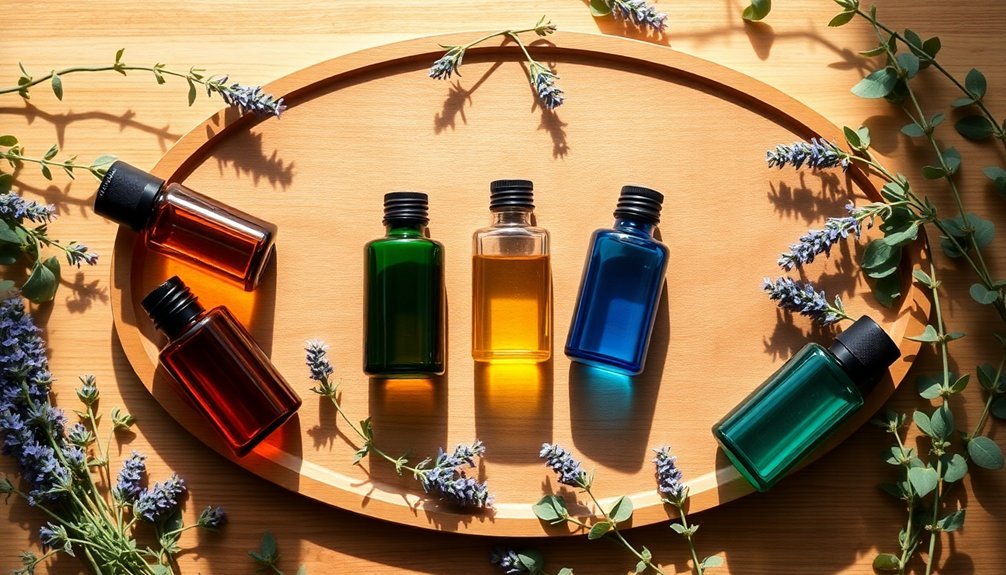
When creating essential oil blends, you'll want to focus on combining scents that naturally complement each other across fragrance families like citrus with florals or woody with herbals.
You can build depth by layering your oils according to their note categories – starting with quick-evaporating top notes, adding balancing middle notes, and anchoring with lasting base notes.
Understanding these natural pairings helps you achieve the perfect balance of aromas while ensuring each oil contributes meaningfully to your blend.
Harmonizing Scent Families Together
Successfully blending essential oils requires understanding how different scent families work together to create harmonious combinations.
You'll find that certain scent families naturally complement each other, while others need careful balancing to work well together.
- Citrus oils like bergamot and lemon blend beautifully with florals such as lavender and rose geranium, creating bright, uplifting combinations.
- Woody scents like cedarwood and sandalwood provide an excellent foundation when paired with spicy oils like cinnamon and ginger.
- Herbal oils such as basil and chamomile work well with spicy notes, adding depth and complexity to your blends.
- Fresh scents can be balanced with earthy ones – try combining bergamot with patchouli or vetiver for a grounding yet invigorating aroma.
Start with equal proportions and adjust based on each oil's strength until you achieve your desired scent profile.
Understanding Oil Note Layers
Beyond harmonizing scent families, mastering the layered structure of essential oil notes helps create complex, lasting aromas.
Think of these layers as a three-act performance: top notes like citrus and mint provide the opening act, lasting 5-20 minutes; middle notes such as lavender and geranium deliver the main story for up to 3 hours; and base notes including sandalwood and vanilla create the lasting impression for 6+ hours.
To blend these notes effectively, follow the 30/50/20 rule: use 30% top notes, 50% middle notes, and 20% base notes.
For a 10-drop blend, that's 3 drops of top notes (like bergamot), 5 drops of middle notes (like lavender), and 2 drops of base notes (like frankincense).
You can adjust these ratios based on your preferences and the oils' strengths.
Balance Through Natural Pairings
Creating harmonious essential oil blends requires understanding natural pairings across fragrance families. When combining oils, you'll find that certain families naturally complement each other, creating balanced and effective aromatherapy blends.
- Floral oils like Lavender and Rose Geranium pair beautifully with citrus oils such as Bergamot, creating uplifting yet calming combinations.
- Woody oils like Cedarwood and Sandalwood blend seamlessly with both florals and spicy oils, adding depth and grounding qualities.
- Herbal oils such as Basil and Clary Sage work well with earthy and spicy notes, perfect for creating focused blends.
- Citrus oils complement almost every family, especially florals and herbs, making them versatile mixing partners.
Start with these natural pairings as your foundation, then experiment with ratios to achieve your desired therapeutic effects.
Balancing Therapeutic Properties
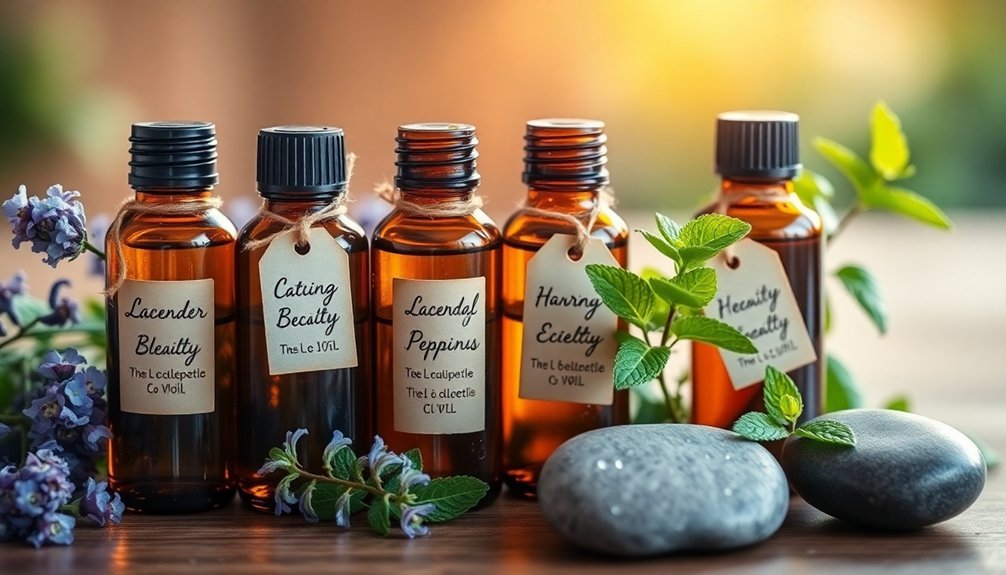
The art of balancing therapeutic properties in aromatherapy requires a deep understanding of how different essential oils interact and complement each other.
You'll want to take into account both the notes and therapeutic benefits when creating your blends. Start with middle notes like lavender or rosemary as your foundation, making up about 50% of your blend.
When combining oils for specific benefits, you'll need to adjust ratios based on their strength. For example, if you're creating a stress-relief blend, you'll use more lavender to balance the stronger chamomile.
Don't forget to take into account the therapeutic goals – whether it's pain management, improved sleep, or mood enhancement.
You can even enhance your blends by incorporating CBD oil, which works synergistically with essential oils to boost their healing properties.
Creating Harmonious Scent Layers
While mastering aromatherapy requires technical knowledge, successful scent layering depends on understanding how different essential oil categories interact with each other.
You'll want to start with base notes as your foundation, then build up through middle notes to top notes, allowing each layer to dry completely before adding the next.
When creating your blend, consider these essential guidelines:
- Match oils within the same category (like floral with floral) or use complementary categories for balanced combinations
- Test your blends on blotter papers first to observe how the scents interact over time
- Document successful combinations in your aromatherapy journal for future reference
- Rotate your fragrances seasonally to maintain freshness and adapt to changing environments
Remember to start simple with two-scent combinations before experimenting with more complex layering techniques.
Proper Storage and Aging Techniques

Once you've mastered the art of blending aromatherapy combinations, proper storage becomes your next key focus.
Store your essential oils in dark glass bottles with airtight lids, preferably amber or cobalt-blue, to protect them from UV light and oxidation. Keep them in a cool, dry drawer or cabinet at 45-50 degrees Fahrenheit, away from heat sources and direct sunlight.
When you create blends, let them mature for at least 48 hours to allow the fragrances to meld properly.
You'll want to use wooden storage boxes or specialized organizers to keep your collection secure and well-organized. Don't store oils in plastic containers or the freezer, as this can compromise their quality.
Remember to check your oils regularly and maintain consistent storage conditions to preserve their therapeutic properties and extend their shelf life.
Frequently Asked Questions
How Long Can I Keep My Essential Oil Blends Before They Expire?
Your essential oil blends will last 1-8 years depending on the oils used. You'll get shorter life from citrus oils (1-2 years) and longer from base notes like sandalwood (4-8 years).
Can I Mix Different Brands of Essential Oils Together?
Yes, you can mix different brands of essential oils together as long as they're pure and high-quality. Just verify all oils come from reputable suppliers and follow proper safety guidelines for blending.
Should I Dilute My Blends Differently for Children and Elderly?
Yes, you'll need different dilution rates. Use 0.1-0.5% for infants, 1-2% for young children, and 1% for elderly or sensitive skin. Always err on the side of caution with these groups.
What Should I Do if I Accidentally Create an Unpleasant Blend?
If you've made an unpleasant blend, don't worry! You can reassess it by testing each oil separately, adjusting ratios drop by drop, or diluting with carrier oil. You can also repurpose it for cleaning.
How Many Different Essential Oils Can I Safely Combine in One Blend?
You can safely blend 4-5 oils for aesthetic purposes, or up to 20 for therapeutic blends. It's best to start with fewer oils and gradually add more while tracking your combinations' effectiveness.
In Summary
You're now equipped to create beautiful, therapeutic aromatherapy blends by following these seven essential rules. Remember to test your combinations, respect proper proportions, and consider both scent families and therapeutic properties. Don't rush the process – take time to experiment with different notes and allow your blends to mature. Store your creations properly, and you'll enjoy the benefits of perfectly balanced aromatherapy combinations for months to come.

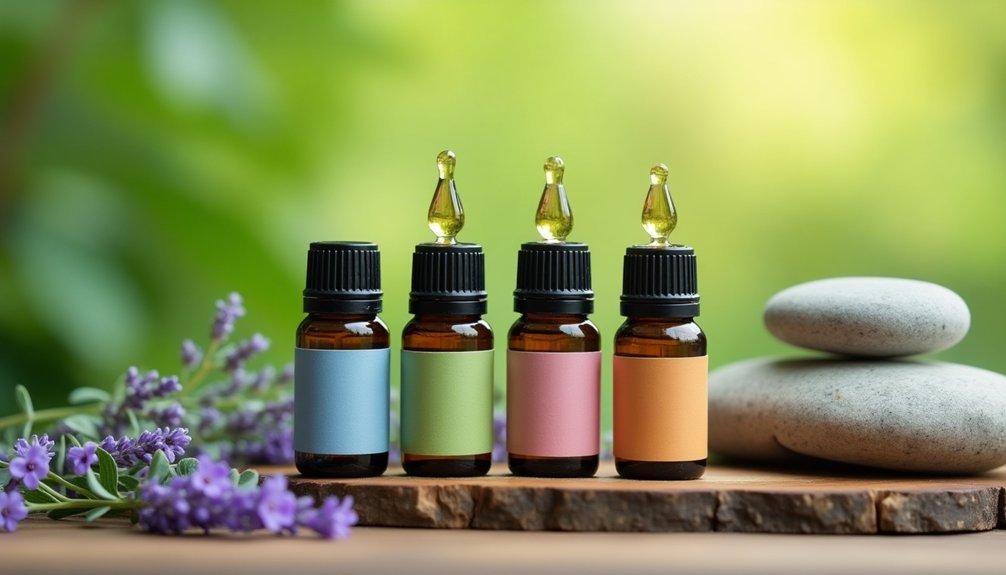



Leave a Reply